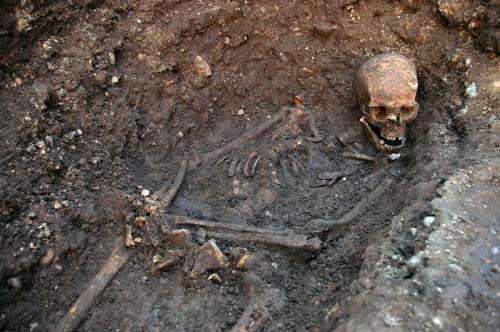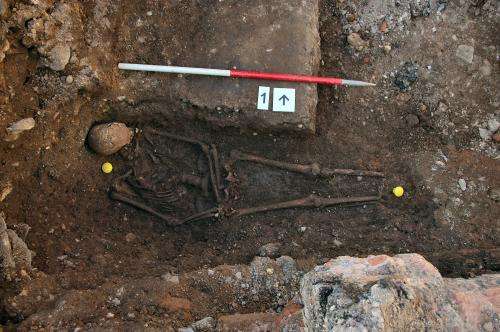King Richard III found in 'untidy lozenge-shaped grave'

An academic paper on the archaeology of the Search for Richard III reveals for the first time specific details of the grave dug for King Richard III and discovered under a car park in Leicester.
University of Leicester archaeologists have published the first peer-reviewed paper on the University-led archaeological Search for Richard III in the prestigious journal Antiquity.
The paper reveals:
- Richard III was casually placed in a badly prepared grave – suggesting gravediggers were in a hurry to bury him
- He was placed in an 'odd position' and the torso crammed in
- The grave was 'too short' at the bottom to receive the body conventionally
- Someone is likely to have stood in the grave to receive the body – suggested by the fact the body is on one side rather than placed centrally
- There is evidence to suggest Richard's hands may have been tied when he was buried
The paper - by a team from the University of Leicester Archaeological Services, School of Archaeology and Ancient History, and Department of Genetics - follows the public revelation in February by the University of Leicester that the University had discovered King Richard III.
It followed a three-week dig started in August 2012 at what was once the medieval Grey Friars church in Leicester – now a Leicester City Council car park.
The paper reveals that the King's grave was too short for him and had an untidy "lozenge" shape, with the bottom of the grave much smaller than it was at ground level.
The head was propped up against one corner of the grave, suggesting the gravediggers had made no attempt to rearrange the body once it had been lowered in.
There were also no signs of a shroud or coffin.
This is in stark contrast to the other medieval graves found in the town, which were the correct length and were dug neatly with vertical sides.
This may show that the gravediggers were in a hurry to put the body in the ground – or had little respect for the deceased.

This is in keeping with accounts from the medieval historian Polydore Vergil, who said Richard III was buried "without any pomp or solemn funeral".
'The king in the car park': new light on the death and burial of Richard III in the Grey Friars church, Leicester, in 1485 is the first academic paper to be published on the University of Leicester's Search for Richard III.
It outlines the key findings from the archaeological investigation of the Grey Friars site.
It includes analysis of Richard III's grave and explains the conclusions about the friary's layout based on the remains of the church and cloisters.
It also includes initial observations of the King's skeleton.
The paper was written by key members of the University's Search for Richard III, including lead archaeologist Richard Buckley and Grey Friars site director Mathew Morris.
It also includes contributions from osteoarchaeologist Dr Jo Appleby, geneticist Dr Turi King, medieval friary expert Deirdre O'Sullivan and Professor Lin Foxhall, Head of the University's School of Archaeology and Ancient History.
The authors state in the paper: "The Grey Friars Project has been unusual in the nature of the collaboration between professional and academic archaeologists, an amateur group (the Richard III Society) and the City of Leicester. However, this also means that the project has addressed two different but overlapping sets of research questions, not all of which specialists would routinely ask.
"Projects developed in this way may become more common in future as non-specialists increasingly become users, stakeholders and participants in academic research. What is somewhat different from the ways in which archaeological professionals and amateurs have generally worked together is that in this case the non-specialists played a role in shaping the intellectual frameworks of the project, although the final project design (including how questions could appropriately be asked of the evidence), and the execution of the project in practical terms remained in the hands of the archaeologists.
"Grey Friars offers a case study for addressing the issues of how to formulate multiple sets of research questions and aims, and how different kinds of partners can accommodate each other's questions.
"The paper highlights the fact that this was a public archaeology project initiated by Philippa Langley, a member of the Richard III Society, and executed by a team of archaeologists and other specialists from the University of Leicester."
They conclude: "At this stage we have discovered enough of the plan of the Grey Friars precinct to feel confident that we have identified parts of the eastern range, the chapter house and the eastern end of the church, including the transition between the choir and the presbytery.
"This means that the hastily constructed grave in Trench 1 is certainly in the place indicated by the fifteenth- and sixteenth-century written sources as the tomb of King Richard III.
"The radiocarbon dates, evidence on the male skeleton of severe scoliosis, trauma consistent with injuries in battle and potential peri-mortem 'humiliation injuries', combined with the mtDNA match with two independent, well-verified matrilineal descendants all point clearly to the identification of this individual as King Richard III. Indeed, it is difficult to explain the combined evidence as anyone else.
"This result is the most important one for our non-specialist partners, as well as for millions of people around the world, and addresses their key questions."
The paper acknowledges the support of the Richard III Society, Leicester Shire Promotions, Leicester City Council and others.
Commenting on the paper Professor Chris Scarre, editor of Antiquity, said: "This discovery has been a focus of major public interest and debate, and we are delighted to publish the details of the excavation that have helped lead the team to their conclusion."
The full outcomes from the bone analysis and DNA tests will be published in subsequent papers.
More information: antiquity.ac.uk/ant/087/ant0870519.htm
Journal information: Antiquity
Provided by University of Leicester



















